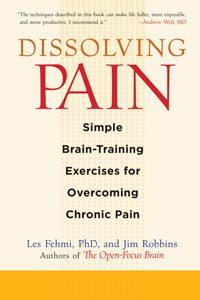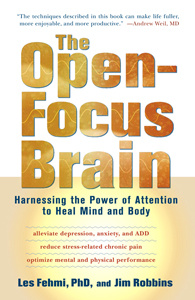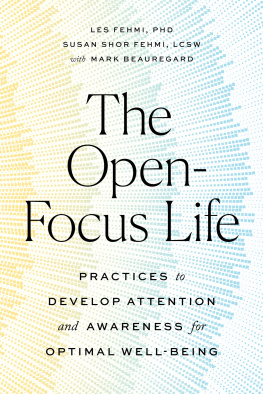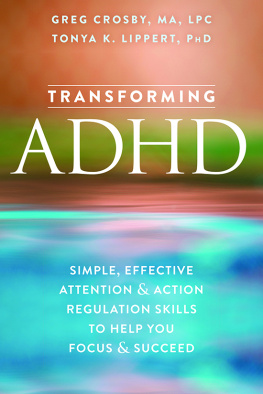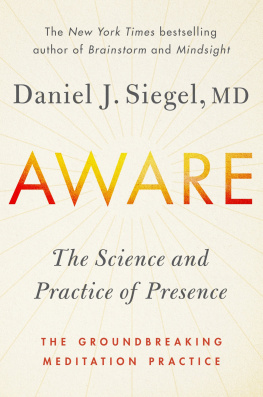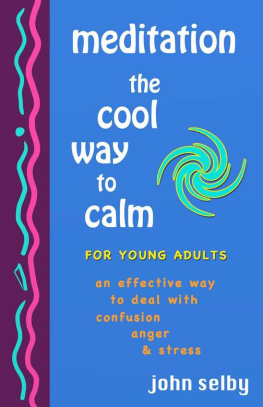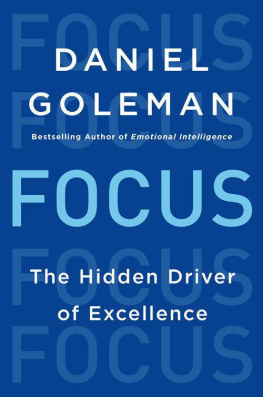The
Open-Focus
BRAIN
Harnessing the Power of
Attention to Heal Mind and Body
Les Fehmi, PhD, and Jim Robbins

TRUMPETER
BOSTON & LONDON / 2011
This book is not intended to substitute for medical advice or treatment.
TRUMPETER BOOKS
An imprint of Shambhala Publications, Inc.
Horticultural Hall
300 Massachusetts Avenue
Boston, Massachusetts 02115
trumpeterbooks.com
2007 by Les Fehmi, PhD, and Jim Robbins
Open Focus is a registered trademark of Biofeedback Computers, Inc.
All rights reserved. No part of this book may be reproduced in any form or by any means, electronic or mechanical, including photocopying, recording, or by any information storage and retrieval system, without permission in writing from the publisher.
Library of Congress Cataloging-in-Publication Data
Fehmi, Les.
The open-focus brain: harnessing the power of attention
to heal mind and body / Les Fehmi and Jim Robbins.
p. cm.
Includes bibliographical references and index.
eISBN 978-0-8348-2271-9
ISBN 978-1-59030-376-4 (hardcover: alk. paper)
ISBN 978-1-59030-612-3 (paperback: alk. paper)
1. PsychologyMiscellanea. 2. Attention
Physiological aspects. I. Robbins, Jim. II. Title.
RC480.5.O6443 2007
616.89dc22
2006103033
Compared to what we ought to be, we are only half awake. Our fires are damped, our drafts are checked. We are making use of only a small part of our possible mental and physical resources.
WILLIAM JAMES, from an address to the
American Philosophical Association,
Columbia University, 1906
T HE HUMAN mind is essential to life as we know it. Everything created by humansfrom artwork to architecture to automobiles to our school systems and foreign policyhas its origin in the mind. Critical decisionswhether to go to war, what to create, whether to protect the environment, what to buy and sellvirtually everythingare based on decisions made by a human mind. The health and well-being of our civilization, it could be argued, rests on the health and well-being of our central nervous system and its offspring, the mind.
But the mind is a funny thing. We assume, if we think about it, that our mind is what it is, and theres little we can door should doto change it. And because we may have lived with anxiety or depression or ADD for so long, we may not realize how serious our problem is or what life is like without it.
But we have all had expansive experiences. We may have traveled to Europe or backpacked in Yellowstone or stayed for a week at summer camp or fallen in love, or have done all of those things. And when we come back from these expansive experiences we feel different.
These experiences are more than fleeting bouts of pleasure or momentary lapses in the anxiety or depression or boredom of the stressful lives we endure the rest of the time. They show that we can move out of the flat, two-dimensional world that is all too often our daily life into a broad, multidimensional range of sensations, perceptions, and awareness that we only experience once in a while.
The question, of course, is how to make these changes. There are a number of different approaches, from religious faith to yoga to meditation to medications to exercise to the arts.
Another is neurofeedback, a very simple computerized form of biofeedback that allows the user to gain control of his or her brain waves simply by being able to see on a computer screen what their brain waves are doing. I was stunned by how well something as simple as neurofeedback could treat attention-deficit/hyperactivity disorder (ADHD), anxiety, depression, and a host of other ailments and wrote about it in my 2000 book, A Symphony in the Brain: The Evolution of the New Brain-Wave Biofeedback.
In 1998, while researching that book, I walked into Les Fehmi and Susan Shor Fehmis office, a warren of rooms full of wires and strobe lights and CD players, and had Les place five saline sensors of his neurofeedback equipment on my head.
The concept is simple. Fehmis brain-wave biofeedbackwhich he calls brain-wave synchrony trainingis little more than a sophisticated mirror that lets your brain see what its doing when you are producing specific brain waves that are the hallmark of specific forms of attention that Fehmi calls Open Focus.
For half an hour I sat in a chair with my eyes closed, receiving light and sound feedback. I also listened to a tape of what Fehmi calls guided imageless imagery. It didnt take conscious effortthe central nervous system responds automatically to this special form of light-and-sound feedback. Fifteen minutes into the very first session I could feel changes taking place. Clenched muscles that I didnt know were clenched were letting go, and a calm settled over me. When I stood up I was slightly disoriented and knew a great deal of stress had been released. I wanted more. Fehmi gave me several recorded Open-Focus exercises and told me to listen to them twice a day. But three times a day, he said, is like a bottle rocket.
Like many people, I had become habituated to the stress I carried. I didnt know how bad it was until I began to release it.
Open-Focus attention changed many things for me and for the people whose stories are presented in this book. It was during an exercise with Fehmi that I finally understood the essence of Open Focus. As I sat in a chair, Fehmi showed me a reproduction of Christinas World, the well-known painting by Andrew Wyeth. It depicts a girl reclining in a field who looks toward a house in the distance. As I looked at the painting, I saw Christina as foreground and everything elsethe grass field she was crawling across, the house and shed and skyas background. After a twenty-minute, eyes-closed Open-Focus exercise, I relaxed and looked at the painting again: It was a revelation. This time my eyes took in the whole painting simultaneously: Christina, the field, the house, and the sky were all one whole picture. My eyes didnt go from her to the house to the shed to the sky. It was a subtle but dramatic difference. I knew then that I wanted to write a book about attention and how it shapes awareness.
Many journalists get into the business because they want to right the wrongs they see in the world. That was certainly my motivation. I started reporting on the environment. And I wrote about severely abused children. As a journalist Ive always striven to get above ground level to look at the big picture, and so to discern the root causes of our problems.
In the last ten years or so I have come to realize that manyif not mostof the grievous problems we face spring, in large part, from the same source. We are a species and a culture that, through our attention habits, carry past wounds that cause anger, fear, longing, and sorrow. These affect our lives far more deeply than we realize. We see the world through an imperfect lens, which deeply colors our perceptions, making us more angry, fearful, sorrowful, and overwhelmed than we need to be. Our attention habits, and the emotions they repress, keep us separate from the world, from feeling part of it; they prevent us from fully sensing what is around us and participating in it. As a result, we are unable to fully engage the here and now. The cruel irony is that because we have no other frame of reference, because we do not pay attention to how we pay attention, we think we are seeing the world as it is.
But we have the power to change. It starts with how we pay attention. Les Fehmi has made an important discovery about the role of attention in human behavior and physiology, and it should open a new dialogue about the human condition.
Next page
